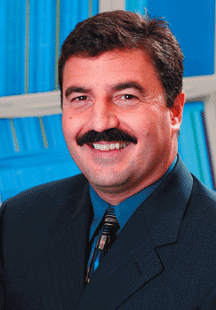The Market Cycles
by Jayanthi Gopalakrishnan & Bruce Faber
Anthony J. Saliba began his career trading equity options as an independent market maker at the Chicago Board Options Exchange (CBOE) in 1979. Over the next decade, he gained extensive experience in trading currencies, equities, and Standard & Poor's 500 and S&P 100 contracts. In each of these markets, he emerged as a leading and respected presence, and quickly acquired a reputation as one of the top traders. His trading accomplishments, most notably his success during the market correction of 1987, earned him a place in the national bestseller Market Wizards.Due to his innovative trading ideas, Saliba has become an internationally recognized consultant on the emergence and function of electronic markets and trading systems. He is often quoted in industry publications, including The Wall Street Journal and Financial Times, and is frequently invited to speak at industry forums. He has founded numerous industry-related companies including LiquidPoint, a broker-dealer offering options execution/facilitation for many large Wall Street firms; Saliba Portfolio Management, a portfolio management firm providing state-of-the-art investment enhancement techniques through the use of options; and the International Trading Institute, a derivatives training company. His latest book, Option Strategies For Directionless Markets, is available from Bloomberg Press.
STOCKS & COMMODITIES Editor Jayanthi Gopalakrishnan (JG) and Staff Writer Bruce Faber (BF) interviewed Anthony Saliba on March 11, 2008, via a conference call.

In options, it is not a zero-sum game at all.
Tony, why don't you tell us about yourself and how you got interested in trading options.
I took a job as a stockbroker right out of college. Since options were the latest thing, they gave it to the new kid to read and learn about. This was in 1977 and options had been around for about three and a half years, but most shops -- and this was a small brokerage firm out of Indianapolis -- weren't dealing with options at all. But these were two fairly progressive guys who said, "Hey, kid, you should learn about options. It's the new thing. You're right out of school, and it fits what you probably want to do."
So I read everything I could get my hands on about it, and took a liking to it. There were a bunch of market timer- and daytrader-sort of magazines that were circulating at the time, and I subscribed. It was a way for me to learn more than the average person. It was interesting, and I actually developed a small clientele while I was there.
One day I asked one of the old guys smoking a cigar -- back then you could smoke in the offices -- "Who makes all the money in this industry?" At that point I was out selling economic development bonds in rural Indiana to farmers. Back then a big day on Wall Street was 11 million shares, and these days we do that in the first 30 or 40 seconds of the open. Anyway, the old guy said, "You've got to be down on the floor." And I said, "I know what that means." I grew up in Highland Park, which is a northern suburb of Chicago. So I came back to Chicago to be with my roots.
JG: So then you started on the floor.
I started on the floor as a clerk. Within about three months, the guy I was clerking for gave me a trading account on the side. I put on some strategies I thought might work, like simple spreads, while I did my clerking functions.
Then one day I met a guy I had caddied for as a kid who was a member on the floor, but he really didn't know much about trading. I showed him how to do this spread and I helped him put it on and he made a lot of money. He came back and said, "Hey, can you do that again?" I said, "Well, yeah." He said, "How would you like to work for me?" I said, "I would be interested in a partnership, if that is what you have in mind." [All I could make sure that I got on the table was that it was a 50-50 deal.] I wasn't going to do that and show somebody how to make money and not get at least half of the profits.
JG: And he said yes?
Yeah. So he put up the money and within a couple of years, I bought him out. I made him hundreds of thousands of dollars in profits and then I struck out on my own and started hiring young people to clerk for me. I taught them how to trade. I taught them what I had learned. By 1987, I had about 27 traders working for me. Then I decided that I needed to figure out a way to train these people besides teaching them myself. I had hand-trained each and every one of them -- at that time I was 32 or 33 -- but it was getting exhausting. At that point, the personal computer wasn't really a business tool. There was really only the Apple Macintosh and the IBM PC. It wasn't very business-friendly.
...Continued in the May 2008 issue of Technical Analysis of STOCKS
& COMMODITIES
Excerpted from an article originally published in the May 2008 issue
of Technical Analysis of STOCKS & COMMODITIES magazine. All rights
reserved. © Copyright 2008, Technical Analysis, Inc.
Return to May 2008 Contents